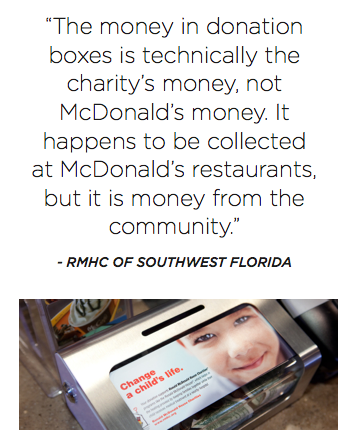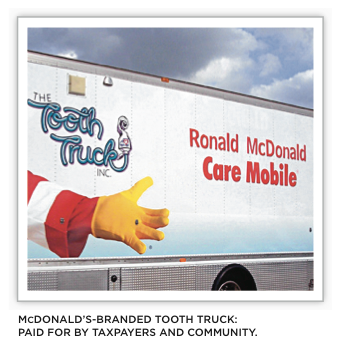Q: How Much Money Does McDonald’s Give to Ronald McDonald Houses? A: Not Much
If you’re ever driven past or needed one of the 322 Ronald McDonald Houses I’m assuming like me your heart warmed at the iconic clown who provides “a loving home away from home to families needing to be near their seriously ill or injured children while they’re being treated at metropolitan area hospitals.” Based on promotional materials like their own website Ronald McDonald House creates massive goodwill by branding themselves as the corporation who cares for children and their families.
Let’s talk about the value of goodwill. In 2012 Mc Donald’s reported its goodwill at $2.8 billion (up from $2.7 billion in 2011) [McDonald’s 2012 Annual Report, page 30]. It would be foolish for us to to shun cause marketing but we still need to look at it with a critical eye. Quite a bit of that goodwill stems from the easily identifiable Ronald McDonald character and the tacit association between Ronald McDonald and healing families is absurd on a good day and offensive on a bad one.
If McDonald’s was actually funding these Ronald McDonald Houses I think I’d be able to turn a blind eye. The fact is that they are donating miniscule amounts to the operating budgets of these very important facilities while reaping untold advertising benefits.
Fact: Ronald McDonald Houses operate at the local level where they have their own non profit status and have licensing agreements with McDonalds’s for the use of the Ronald McDonald brand. Ken Barun states: We have sort of franchised the charity business.
Fact: The Tallahassee Ronald McDonald House told Corporate Accountability International that about 10 percent of their operating budget come from McDonald’s through local fundraisers and donation boxes.
Fact: The Dallas RMHC chapter says that only 5% of it’s budget come from both MdDonald’s and RMHC global in 2012.
Question: When 90-95% of your funds come from the community you serve why not rebrand as a Community Home?

Fact: McDonald’s places RMHC Donation Boxes in some of it’s outlets and makes a big deal of this in much of it’s communication about RMHC. The corporation calls it “our system’s largest ongoing fundraisers,” and boasts that in 2012 more than $50 million was collected worldwide.
Fact: In 2012 McDonald’s customers gave 1.5 times more to the RMHC than the corporation itself donated in 2011.
Fact: McDonald’s spent at least $18 million on a campaign that would donate one penny of every Happy Meal to the RMHC Foundation. McDonald’s estimated that it might raise $6.4 million.
Question: Does this violate the Pledge McDonald’s took to not market junk food to kids?

Fact: There is a “Tooth Truck” in the Ozarks that bears the Ronald McDonald image. The annual operating budget of the Ronald McDonald Care Mobile is $600,000 half of which is funded through Missouri Medicaid and the other half comes from community donations.
Question: Did the State of Missouri just fund McDonald’s advertising with $300,000?
Fact: Schools are rewarded with visits from Ronald McDonald when they collect pop tabs (pull tabs from soda cans). A boy in Sacramento, CA led his classmates in collecting 179 pounds of pop tabs (think about how much soda that is) and generated $12.57 for the Ronald McDonald House of Sacramento.
Question: How can anyone take this seriously?

Fact: In 2012 the average McDonald’s worker made $8.25 an hour. The CEO was rewarded with an $8.75 million salary not including a 3-year bonus.
Fact: A report from the National Employment Law Project found that McDonald’s topped the list of fast food corporations whose workers rely on government assistance programs to make up for low wages. Forbes reported that McDonald’s cost taxpayers $1.2 billion annual in public assistance programs for their low-paid workers.
Question: Maybe the Tooth Truck is a $300,000 red herring? Oh nevermind. It all matters.
Many organizations no longer accept charitable donations from tobacco corporations and it’s my sincerest hope that the same will soon be said for food corporations with a similarly profound negative impact on public health. I suspect that in 5 or 10 years we’ll look back on Ronald McDonald with the same disbelief as Joe Camel.
You can read the full report at StopCorporateAbuse.org.
All photos are courtesy of Corporate Accountability International.